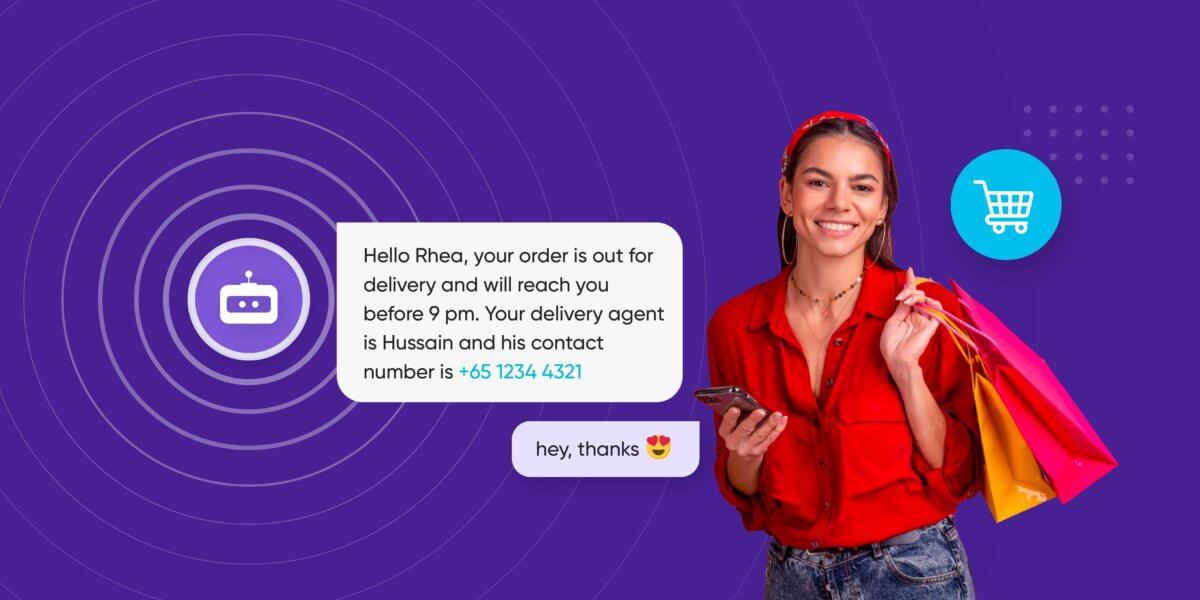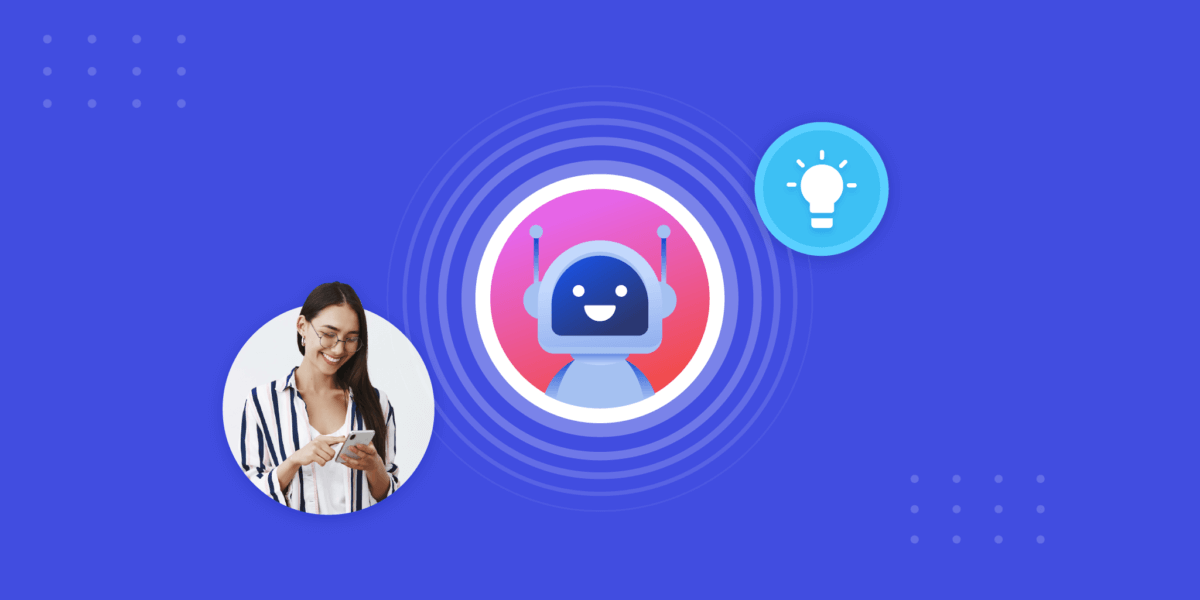
8 Ways To Make Your Chatbot More Contextually Intelligent
- August 14th, 2025 / 5 Mins read
-
 Aarti Nair
Aarti Nair
Why context is the missing ingredient in most chatbots
Have you ever had to explain the same issue to a chatbot three times, only for it to give you a generic, copy-paste answer? It’s frustrating — and you’re not alone. According to PwC, 40% of consumers stop interacting with a chatbot after just one bad experience. In most cases, that “bad experience” boils down to one thing: the chatbot had no context.
The problem is that many bots treat every conversation as a blank slate. They don’t remember your last message, your purchase history, or the details you shared five minutes ago. They ask the same questions, give the same scripted replies, and fail to adapt when the conversation changes direction. For the customer, it feels less like talking to a helpful assistant and more like hitting a digital wall.
This is where contextual chatbots change the game. Instead of treating every interaction as new, they remember, understand, and respond based on past exchanges, stored customer data, and even relevant documents. Think of them as the difference between a receptionist reading from a generic script and a personal concierge who knows your name, preferences, and needs before you even say a word.
And here’s the kicker — the stakes for getting this right are higher than ever. McKinsey research shows that 71% of customers expect companies to deliver personalised interactions, and 76% get frustrated when that doesn’t happen. If your chatbot isn’t meeting that expectation, you’re not just missing an opportunity — you might be driving customers straight to your competitors.
So, what exactly is a contextual chatbot, and why is it becoming a must-have rather than a nice-to-have? Let’s start with the basics.
What does context mean in chatbots?
How does a contextual chatbot affect conversations?
Essential features of intelligent, contextually-aware chatbots
How to build a contextual chatbot? Here are 5 ways.

What does context mean in chatbots?
Context refers to circumstances surrounding an event, statement, or idea that allow it to be fully understood. For a chatbot, however, the context is a JSON object (an open data interchange format used to store and transfer data that is both human and machine-readable) passed from your application to the chat service of the customer. It is your application’s responsibility to keep the context consistent from one conversation turn to the next.
Context can be pulled from anywhere that has valuable information, including past records, meeting agendas, chat histories, email messages, and even browsing activity. It can be information such as a customer’s name, their agenda or goal from the interaction, and world knowledge about the topic in question.
What is a Contextual Chatbot?
A contextual chatbot is more than a programmed question-and-answer machine. It’s an AI-powered assistant that remembers previous conversations, understands the intent behind a query, and uses relevant data — from customer profiles to company documents — to provide accurate, personalised responses.
Think about the difference between two customer service agents. One greets you like it’s the first time you’ve ever spoken, asks you to repeat your account number, and gives you a generic answer. The other remembers your last query, knows your purchase history, and picks up the conversation right where you left off. Which one would you prefer? That’s exactly the gap contextual chatbots fill.
Unlike basic, rule-based bots that rely solely on predefined scripts, contextual chatbots leverage tools like:
-
Large Language Models (LLMs) to interpret complex queries and natural language.
-
System variables to store customer-specific details like order IDs or preferences.
-
Document cognition to pull relevant information from manuals, FAQs, and internal policies.
-
CRM and data platform integrations to access real-time customer information.
-
Omnichannel context retention so conversations feel seamless across web, mobile, messaging apps, and voice.
By combining these capabilities, contextual chatbots can adapt dynamically to each user. They don’t just answer the question you ask — they respond in a way that makes sense for you, in that moment.
Now that we know what a contextual chatbot is, the next question is — why does it matter so much for your business?
How does a contextual chatbot affect conversations?
Chatbot maturity levels can be used as a parameter to estimate your bot’s readiness for the market. If a young bot is expected to handle roughly 20% of common customer issues, a mature bot is expected to handle over 80% of recurring questions to cultivate valuable customer relationships. This is achieved with the help of mature AI technology that blurs the line between a bot and a human. Ideally, the consumer should be unable to tell whether he or she is speaking with a bot or a human.
- Immature: An immature chatbot does not use Natural Language Processing (NLP) and cannot learn by itself from its interactions with customers. Therefore, it can only engage in simple (direct) question-and-answer actions.
- Infant: An infant chatbot uses simple NLP to answer questions and perform actions, but it still cannot learn by itself.
- Mature: A moderate-level chatbot can use NLP to have a decent conversation with customers as well as undergo supervised learning.
- Advanced: An advanced chatbot uses NLP and can understand the context and learn from customer interactions.
- Futuristic: A futuristic chatbot will be able to have a fluent conversation by utilising NLP, context, and emotional understanding and responsiveness. It can also learn and adapt to the needs of the customer.
Why Contextual Chatbots are Important?
Customer expectations have changed dramatically in the past few years. Generic responses and repetitive questions no longer cut it. According to McKinsey, 71% of customers expect companies to deliver personalised interactions, and 76% feel frustrated when this doesn’t happen. That frustration isn’t just an emotional reaction — it’s a business risk. Dissatisfied customers are more likely to abandon purchases, leave negative reviews, or simply switch to competitors who make them feel understood.
A non-contextual chatbot can easily become a bottleneck in your customer journey. It may answer queries, but without context, it risks offering irrelevant information, asking for details customers have already shared, or failing to recognise repeat issues. The result? Longer resolution times, higher abandonment rates, and lower satisfaction scores.
On the flip side, a well-designed contextual chatbot acts like a knowledgeable digital representative. It uses memory, real-time data, and even environmental cues to respond accurately and empathetically. This means customers spend less time explaining, get answers faster, and feel like their needs are genuinely being met.
And there’s a bottom-line impact too. Businesses that implement context-aware bots often see:
-
Reduced support costs due to fewer escalations.
-
Higher conversion rates from personalised offers.
-
Improved customer retention through better experiences.
Simply put, context turns a chatbot from a reactive tool into a proactive business asset. It’s no longer about “Can my bot answer this question?” — it’s about “Can my bot answer this question in the best possible way for this customer, right now?”
Key Benefits of a Contextual Chatbot
If the “why” makes the case for change, the “what’s in it for me?” seals the deal. A contextual chatbot doesn’t just make conversations smoother — it delivers measurable business outcomes. Here’s how it pays off:
1. Higher Customer Satisfaction
When customers don’t have to repeat themselves and get relevant answers instantly, their perception of your brand improves. In fact, customers who have a ‘very good’ service experience are almost 90% more likely to trust a company (Qualtrics XM Institute).
2. Faster Resolution Times
With context, a chatbot skips repetitive questions and dives straight into problem-solving. This reduces average handling time (AHT) and helps more customers in less time — without sacrificing quality.
3. Increased Loyalty and Retention
Personalised conversations create emotional connections. Customers who feel understood are far more likely to return, renew, or recommend your business to others.
4. Improved Agent Productivity
Context-aware bots resolve more queries without escalating to human agents. This frees up your support team to focus on high-value, complex cases — reducing burnout and improving morale.
5. Higher Revenue Opportunities
With access to customer purchase history and preferences, chatbots can recommend relevant products or upgrades at the right time, boosting upsell and cross-sell rates.
The common thread?
Context doesn’t just make for a better conversation — it makes for better business. Now that we know the impact, let’s get into the practical steps: how to actually create a contextual chatbot that delivers these benefits.
Intelligent, contextual chatbot: Essential features
What is an intelligent chatbot? It is a chatbot that can perpetually learn and evolve, comprehend urgency through contextual understanding and engage in seamless agent handover. Not sure, what these terms mean or if they are relevant to your bot? Read on to find out what I mean:
1. Perpetual learning
An intelligent bot should determine whether it knows how to respond to the message accurately based on current knowledge. Over time, this reservoir of past interactions works as a rich source of training data. A bot created to learn continuously from its interactions advances over time. This makes it more efficient and highly accurate in identifying intent in its interactions.
2. Seamless agent handover
An intelligent bot must be able to comprehend the urgency and complexities of a conversation. Even if a chatbot doesn’t understand the query, it should be able to diligently hand over the talks to human support.
3. Contextual understanding
Chatbots must understand context, so customers feel like they are speaking to a person who knows the ins and outs of their case, making the interaction more pleasant and personal.
A contextual chatbot, for example, might be able to determine whether the customer on the other end has any products in their shopping cart ready for checkout or if they have recently complained about a negative customer experience. This allows it to tailor its response and even pass the information on to a human agent.
How to design a perfect contextual chatbot?
perfect contextual chatbot must have human-like conversational abilities and maintain context throughout the chat session. It’s not enough for it to simply answer questions — it should understand the flow of the conversation, remember what’s been said, and adapt based on the customer’s needs. Just like a good customer service agent, it must have a personality appropriate for the domain, because personalities leave an indelible impression. A friendly, empathetic tone can make the difference between a customer feeling valued or feeling like they’re talking to a machine.
So, how do you actually design one that keeps interactions relevant and addresses the problem at hand with sharp contextual attention? Here are some proven ways to get it righ
1. Choosing a holistic NLP framework
NLP facilitates human-machine communication by allowing the chatbot to obtain and process information from written or verbal user inputs without requiring humans to “speak” Java or any other programming language. In essence, a chatbot developer must create a holistic NLP model that enables computers to decode and even mimic the way humans communicate.
Imagine a customer saying, “I’ve been charged twice for my order — again.” A rule-based chatbot might only focus on the “charged twice” part, while an NLP-powered bot will recognise the frustration implied by “again,” check past complaints, and respond more empathetically: “I see this has happened before, and I’m sorry about that. Let me check your order details and process a refund.”
2. Creating “selection masks” or “overlays” of meta-knowledge
“Selection Masks” or “Overlays” are layers of relevant contextual information to ensure AI knows how to address a query with more understanding. One of the critical meta-knowledge dimensions that can be particularly useful as a selection mask is “source attribution”, which could be used to enable context by giving more credence to a specific source over another.
For example, you could program the bot to favour a reputable Journal versus an anonymous social media post when responding to queries. These layers of information must be dynamic to capture recent information, refine scope based on case-specific knowledge, understand the goals of the interaction, and more.
If a user asks, “What’s the latest travel advisory for Japan?”, you could program the bot to prioritise government travel advisories over a personal blog post. These layers must also be dynamic — updating to capture recent information, refining their scope based on case-specific knowledge, and aligning with the goals of the interaction.
3. Educating your chatbot about different types of contexts
Contextual analysis should be embedded from the start when designing the right chatbot. To do so, it is of utmost importance that your chatbot can understand and differentiate between different types of contexts like user context, session/conversation context, and domain-specific and industry context.
Session/Conversation context
All of the information exchanged in previous dialogues between the user, and chatbotis included in the conversation-specific context. Customers can switch between intents and progress toward their goals without having to repeat the same information multiple times throughout their journey.
In a banking bot, if a customer asks about their account balance and then says, “Transfer Ruppes 20000 to savings,” the bot should link the transfer request to the same account without re-asking, “Which account would you like to transfer from?”
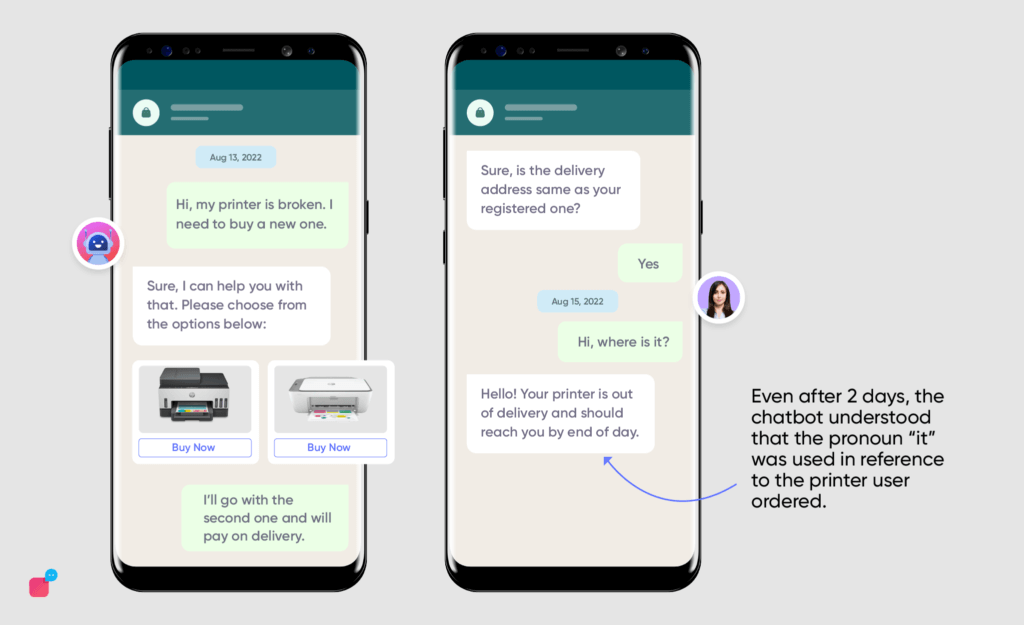
User context
User context, on the other hand, includes information about the user such as name, contact information, last order placed, seat preference in flight, and so on. These are the specifics of a particular user that a contextual chatbot must be aware of. The primary applications of user context are to provide personalised experiences and proactive assistance.
An airline chatbot that remembers a passenger’s window seat preference can offer it by default during booking.
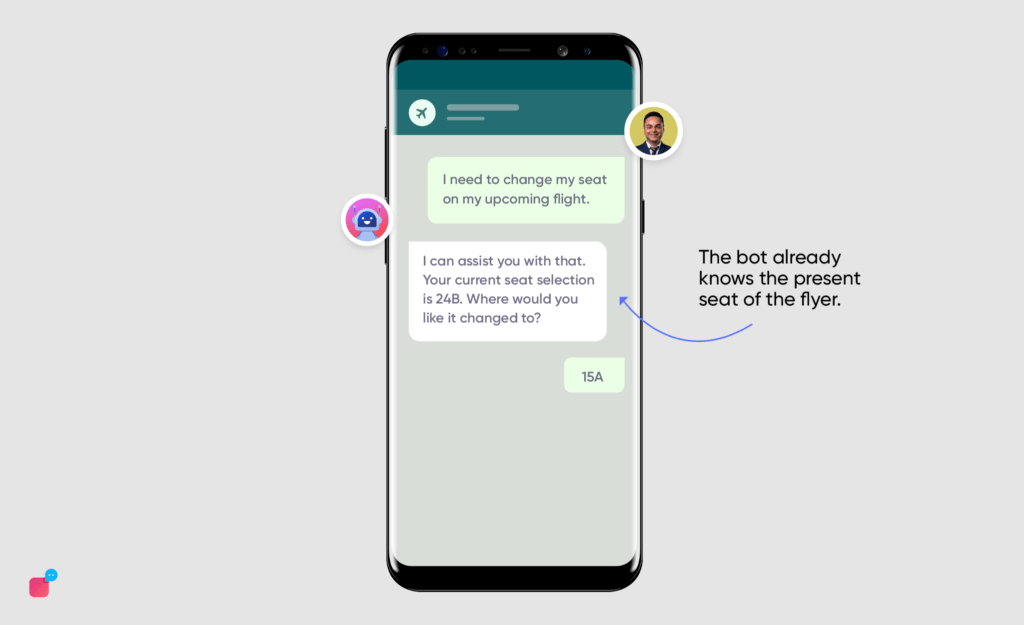
Domain-specific context
Domain-specific context comprises information and widely accepted facts that the customer expects the chatbot to understand during a conversation. Domain knowledge of chatbot support is critical in ensuring that customers do not need to specify every detail in the request explicitly.
A healthcare chatbot should understand what “BMI” means without the user explaining it.
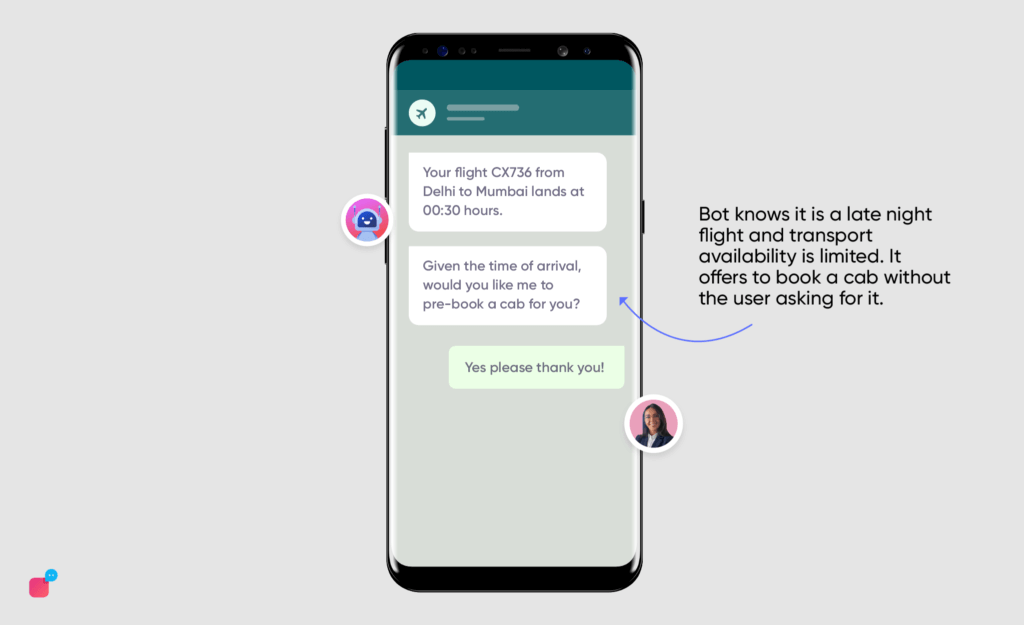
Business/Industry Context
The business/industry context consists of business logic or data that the chatbot must access to respond correctly. This allows it to access third-party data or logic at various stages and predict customer needs.
An insurance chatbot pulling real-time policy data to confirm claim eligibility.

4. Understanding the limitations of human language
Human language is complex and nuanced, and its meaning can change depending on the context. In short, language is ambiguous by nature, vast, versatile, colloquial, dynamic, and highly contextual. A perfect contextual chatbot must be trained to understand the dynamic reality of human language, disambiguate the meaning by considering the context and common patterns in what people say, and learn which words are likely to appear where in the pattern. Also read: What Makes Human to Machine Communication Natural?
If a customer says, “It’s too big for me,” a fashion chatbot must determine if “big” refers to clothing size, package size, or even price — based on what was being discussed earlier in the conversation.
5. Make sure the chatbot is trained on lingual datasets
The chatbot’s vocabulary is frequently limited and primarily derived from what we train it on. A good set of training data and the ability to add synonyms, colloquialisms, slang, dialects, etc., can significantly assist your chatbot in understanding more variations in a phrase. Also read: How Localisation Influences Multilingual Chatbots
A travel chatbot that understands “holiday,” “vacation,” and “getaway” as meaning the same thing will respond more naturally to users from different regions. Similarly, in the food industry, understanding that “chips” in the UK and “fries” in the US refer to the same item prevents unnecessary confusion.
6. Leveraging Large Language Models (LLMs) for Deeper Understanding
While NLP handles the basics of interpreting language, LLMs take it further by understanding nuance, implied meaning, and varied phrasing. They allow the chatbot to engage in more natural, human-like conversations by processing queries the way people actually speak — full of slang, typos, and fragmented sentences.
If a user says, “Need help with that thing I booked last week — it’s messed up,” an LLM-powered chatbot can infer that “thing” likely refers to a booking, identify the time frame from “last week,” and request the exact details without forcing the customer to start from scratch.
7. Using System Variables and Bot Variables to Retain Context
System and bot variables act as the chatbot’s short-term and long-term memory.
-
System variables store data like user ID, session start time, or language preference that persists across the interaction.
-
Bot variables capture dynamic details during a conversation, such as the current order number or support ticket ID, so the bot can reference them later in the same chat or even across multiple sessions.
A customer contacts a telecom provider about a broadband issue. The bot saves their account number as a system variable and the fault ticket number as a bot variable. If the customer comes back a week later asking, “Any update on my case?”, the bot can instantly pull up the ticket without asking them to repeat the details.
8. Implement Smart Fallback and Human Handover
Even the smartest chatbot will eventually encounter a question it can’t answer or a situation that needs human judgment. That’s where smart fallback and seamless handover come in. A well-designed contextual chatbot should know when it’s out of its depth and transfer the conversation to a live agent — while carrying over the entire context so the user doesn’t need to repeat themselves.
Example scenario: A customer using a banking bot reports a possible fraud on their account. The bot recognises this as a high-risk situation, escalates to a fraud specialist, and passes along all previous conversation details, transaction IDs, and timestamps. This ensures the human agent picks up exactly where the bot left off, creating a smooth, stress-free experience for the customer.
TL;DR
A contextual chatbot remembers past interactions, understands customer intent, and uses real-time data to give relevant, personalised responses.
Why it matters:
-
71% of customers expect personalised service.
-
Context-aware bots can deliver 40% higher resolution rates and 8x ROI on targeted offers.
How to design one:
-
Use a holistic NLP framework and LLMs for deeper understanding.
-
Leverage system and bot variables to retain session and user context.
-
Apply meta-knowledge overlays for smarter responses.
-
Train on diverse lingual datasets.
-
Implement smart fallback with seamless human handover.
The payoff: Faster resolutions, happier customers, lower support costs, and higher conversions.
💡 Ready to build yours? Explore Verloop.io’s AI-powered contextual chat and voice agents.
Contextual chatbot are independent and holistic
Intelligent, contextually driven chatbots are essential for the betterment of businesses. Essential aspects of building an intelligent chatbot include selecting a holistic NLP framework, creating selection masks and meta-knowledge overlays, educating the chatbot about different types of context, and enabling it to be able to disambiguate conversations based on context.
The ROI of Getting Context Right
A contextual chatbot isn’t just a tech upgrade — it’s a business advantage. By combining advanced NLP, LLMs, system variables, meta-knowledge overlays, domain understanding, and smart fallback, you create an assistant that works with the customer rather than on them. The result? Conversations that feel effortless, relevant, and genuinely helpful.
The benefits ripple across your business:
-
Happier customers thanks to faster, more personalised responses.
-
Reduced support costs as fewer queries require escalation.
-
Better agent productivity with only high-value, complex issues reaching them.
-
Higher conversion rates through timely, tailored offers.
-
Increased loyalty and retention because customers feel understood.
And it’s not just theory — data shows that companies delivering personalised, context-aware interactions can see up to 40% higher resolution rates and 8x ROI on targeted offers. In a world where 71% of customers expect personalised service, the cost of not getting context right is far higher than the investment in doing it well.
If you’re ready to create a contextual chatbot that drives loyalty, accelerates resolutions, and boosts revenue, explore Verloop.io’s AI-powered contextual chat and voice agents.
Book a demo today and see the difference context can make.

FAQs on Contextual Chatbots
1. What is a contextual chatbot?
A contextual chatbot is an AI-powered assistant that remembers past interactions, understands user intent, and uses stored data, documents, and business logic to deliver relevant, personalised responses. Unlike rule-based bots, it adapts dynamically to each customer and conversation.
2. How is a contextual chatbot different from a regular chatbot?
A regular chatbot typically follows predefined scripts and treats each query as a standalone event. A contextual chatbot, however, retains session, user, and domain-specific context — meaning it can pick up where you left off, offer tailored suggestions, and avoid repetitive questions.
3. Why are contextual chatbots important for businesses?
They improve customer satisfaction, reduce resolution times, and boost loyalty by creating smoother, more personalised conversations. Businesses using contextual bots often see higher resolution rates, fewer escalations, and increased revenue from targeted upsell and cross-sell opportunities.
4. What technologies power a contextual chatbot?
Contextual chatbots rely on a combination of:
-
Natural Language Processing (NLP) for understanding queries.
-
Large Language Models (LLMs) for nuanced interpretation and natural conversation.
-
System and bot variables for memory retention.
-
Meta-knowledge overlays for accurate information sourcing.
-
Document cognition for pulling details from manuals, FAQs, and policies.
5. Can a contextual chatbot work across multiple channels?
Yes. Omnichannel context retention ensures that a conversation can move seamlessly between your website, mobile app, WhatsApp, and even voice channels without losing history or personalisation.
6. How do smart fallback and human handover work?
If the chatbot encounters a query it can’t answer, it triggers a smart fallback — escalating the conversation to a human agent while transferring all relevant context. This means the customer never has to repeat themselves, and the agent can resolve the issue faster.
7. How can I train my chatbot to understand different languages and slang?
Include diverse lingual datasets in its training, with synonyms, colloquialisms, slang, and regional phrases. This ensures the chatbot can respond naturally to varied inputs, making it feel more human-like.
8. What’s the ROI of implementing a contextual chatbot?
Beyond customer satisfaction, businesses can see up to 40% higher resolution rates and 8x ROI on targeted offers. Reduced support costs and improved conversion rates mean the investment pays for itself quickly.




